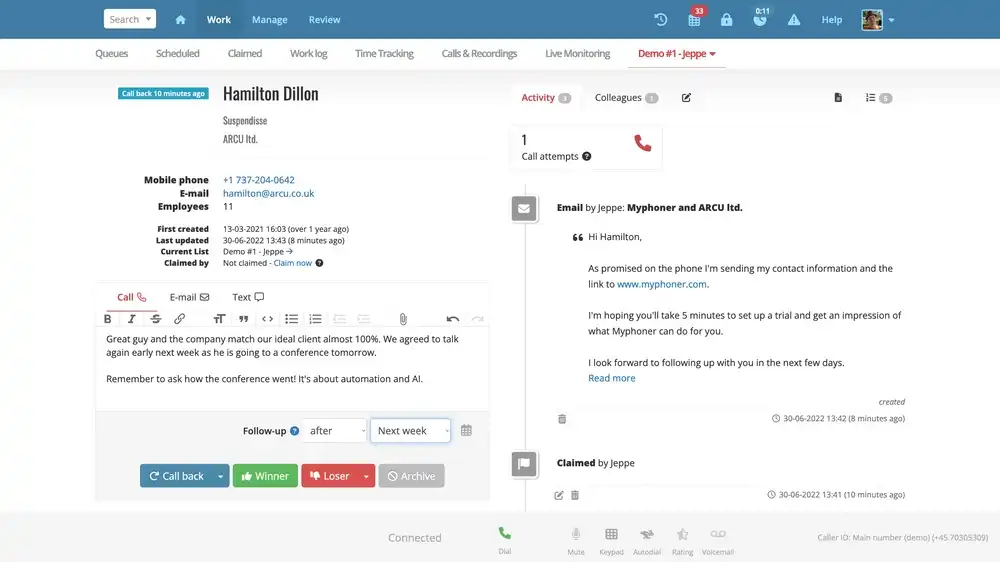Telemarketing Examples

- November 28, 2022
Did you know? Cold calling, otherwise known as "telemarketing", is the most successful sales tool. Calling customers by telephone is the quickest way to reach them directly. That said, around 79% of anonymous calls go unanswered, mainly because consumers believe unidentified calls are fraudulent.
Telemarketing is a hugely popular way of reaching out to individuals to market services. While its basis is in sales, it can also be used to gather data, raise funds for a good cause, conduct surveys or generate leads.
We at Myphoner have been helping software sales teams streamline their telemarketing since 2012. It’s safe to say we know a thing or two about it. So stick with us, as we give you some telemarketing examples that you can implement into your sales team.
What Does Telemarketing Mean?
Telemarketing, often called “telesales” or “inside sales”, involves selling services or products by telephone or online. Think of the times when you’ve received calls from companies imploring you to upgrade your cell phone. That’s telemarketing.
Telemarketers usually call from a sales team specializing in telemarketing, or company offices with under 10 workers (a “call bank”). It’s used in a variety of sectors including:
- Insurance (medical, home, etc.)
- NGO (Non-profit organizations, charities)
- B2B and B2C
- Public service
Quick pause to highlight Myphoner. Don't worry, your article resumes below.
Selling to undefined over the phone?
Use our sales dialer to call customers and prospects in undefined at the most competitive rates

The Advantages of Telemarketing in the Digital Economy
Telemarketing plays a phenomenal role in creating leads and a new client base. Using this tactic, a business can reach out to prospective clients and put together lists of new prospects.
The main plus of using telemarketing to market your company is that it enables you to instantly judge how curious a customer is about your service or product. What’s more, it enables you to:
Generate Quality Leads
Telemarketing is one of the quickest ways to secure new clients. As well as building a stronger relationship with existing and prospective clients, telemarketing also enables companies to generate good leads. It allows businesses to connect with potential customers directly, making it one of the most effective sales tools around.
Boost Customer Experience
Telemarketing is a profitable way to link with old leads or inactive customers. It’s lucrative, too - research found it costs around five times more to acquire a new lead than it does to keep hold of a former one. If you consider potential and current clients as associates instead of clients, you’ll guarantee a better customer experience. So, don’t be too quick to remove telemarketing, as it’s a successful marketing tactic.
Diminish Operating Costs
Telemarketing is an economical way to conduct various business processes, including:
- Marketing or selling services and products
- Generating leads
- Carrying out market research
- Informing clients
It’s somewhat less costly than other marketing strategies, particularly when it’s outsourced to the likes of sales CRM, Myphoner. A service such as this provides teams with an effortless yet powerful solution, taking the often low-prestige chore of cold calling to the next level with our Power Dialler.
Supercharge your business's telemarketing today!

5 Telemarketing Strategies To Avoid
Before we look at some good telemarketing examples, let’s examine some strategies that are best avoided. These methods are in violation of the Telephone Consumer Protection Act (TCPA) and could lead to your company getting sued. So let’s get into it.
The “Trojan Horse”
There’s probably been a time you received a call that was puzzling or ambiguous – the cold caller didn't disclose the real reason for the call. This telemarketing strategy is called a “Trojan Horse” – telemarketers use this example to avoid declaring that they’re making a sales call.
Ringing at Strange Times
Typically, a telemarketer will call someone outside of office hours – say, at night, first thing in the morning, or over the weekend. Despite stringent regulations under the PCPA specifying that calls can’t be made before 8 am or beyond 9 pm, numerous telemarketers break these rules and call people at strange hours to execute robocall scams.
Follow-up Phone Calls
Follow-up calls are another strategy that may breach TCPA rules. When a telemarketer fails to get the response they’re looking for, they may decide to make numerous calls during the day. Follow-up calls are irritating and, even worse, could be an autodialer scam that breaks your consumer rights.
“Neighborhood Spoofing”
Right now, Neighborhood Spoofing is taking the world by storm and is especially tricky to handle because it’s a lot more difficult to screen. This is when a telemarketer uses a local area code when they’re trying to call you. As it’s a local number, you’re much more likely to pick up the phone.
Falsifying Their Position of Authority
If a telemarketer states they can get you something, such as a certain product at a specific value, but then aren’t able to deliver on this, they’re falsifying their position of authority. People throughout the USA are tricked out of huge amounts of cash and vulnerable to a TCPA breach, too.
The 10 Best Telemarketing Examples
1. Outbound Call
Otherwise known as cold calls, outbound calls are the most fundamental, though demanding example of telemarketing. They involve cold callers dialing possible clients and leads from telemarketing lists. But they don’t know whether the person has any interest in the service or product – let alone whether they’re aware of the firm they’re representing.
2. Inbound Call
This telemarketing example is when a customer makes a phone call of their own volition to a contact center. Generally, these will be existing customers who’ve purchased from you before. 65% of a company’s business usually comes from repeat customers, so high levels of inbound calls is a good indicator that you’re effectively retaining your customers.
3. Lead Generation
This example is where data is gathered on potential customers. Potential customers are categorized into either ‘prospects’ or ‘leads.’ A telemarketer will gather:
- A person’s age
- Name
- Where they live
Lead generation could also involve cold calling and answering inbound calls as well as data gathering. But this depends on the telemarketer’s role description. When a person is part of a lead generation team, they must have a good eye for detail, as there is more to lead generation than just categorizing and compiling information. You need to know what makes a ‘hot’ lead, that high potential to turn into a sale.
4. Sales
This example is a blend of the various telemarketing examples above. It’s when a telemarketer pursues someone to dive in and purchase an item or buy a service. Sales usually mean a telemarketer will attempt to throw in a few extra services and goods. This act of “upselling” normally supplements the main item (the one the customer was trying to buy in the first place).
5. Technical Support
Another example of telemarketing is if a client reaches out to the company asking for assistance with an issue concerning a service or item. The agent offers tech support as well as software and hardware troubleshooting, including:
- Password resets
- Basic product installation
- Troubleshooting info
- Browser cache cleaning
- Data clearing
6. Political Telemarketing
When the election period rolls around, contenders and political coalitions are allowed to speak to voters by telephone to tell them about their campaigns.
If you have a directed list and high-quality callers, political calls are incredibly efficient at targeting a political candidate’s audience. Political telemarketing is also excellent for sharing events, getting out the vote calls, and communicating appearances.
7. B2B Telemarketing
B2B telemarketing is when one business calls another business in order to:
- Qualify prospects
- Conduct market research
- Generate leads
- Follow up on direct marketing
8. Phone Surveys
This is when a business calls existing clients and asks them multiple questions to determine how happy they are with the brand. Telephone surveys are performed if a business requires instant feedback on what its clients think about the brand, its services, and its products.
With phone surveys, you can:
- Identify customer pain points
- Identify ways in which you can improve your service
- Get an idea of your brand reputation and customer loyalty
- Gives you more information of your customer base
All of this information can be used to help you make impactful business decisions, with the data to back them up. For instance, you could identify an issue with your service and then develop a solution based on customer feedback.
9. Asking for Information
This is an inbound telemarketing example, in which a customer calls a brand to find out more about their products or services. There’s a pretty good chance that the customer is considering a purchase, but still needs a little convincing. This is where a good telemarketer comes in, turning the lead into a customer.
10. Product Sales
This occurs when a representative phones someone in the hopes of convincing them to purchase a company’s goods. A telemarketer usually addresses regular clients or prospective clients who don’t know much about the brand. This can be done both in B2C and B2B businesses.
The Takeaway
Telemarketing involves more than just calling and selling goods and services to people by telephone. A good telemarketer needs to learn and hone the techniques and skills to be the best they can be. Don’t forget, these techniques can't happen overnight.
At Myphoner, we believe in making good sales teams invincible. Our cold calling software will make your sales team work faster, concentrate, and smile, so you can focus on other tasks like closing deals. Say no to feature-inflated CRMs and uncontrollable spreadsheets now. Why not try Myphoner for free today?

Written by
Jeppe Liisberg
Jeppe Liisberg is a forward-thinking entrepreneur and software developer who has built and contributed to multiple successful startups. With a philosophy centered on creating focused, specialized solutions that excel at solving specific challenges, Jeppe founded Myphoner after identifying a critical gap in the market for effective cold calling software.
"I believe that exceptional software should solve one core problem extraordinarily well rather than attempting to be everything for everyone," says Jeppe. "After years in the trenches as an entrepreneur, I couldn't find a cold calling solution that truly met the needs of small businesses and sales teams—so I built Myphoner to fill that void."
Today, Jeppe remains personally invested in Myphoner's success and customer satisfaction, personally welcoming new users and actively responding to feedback. This hands-on approach ensures that Myphoner continues to evolve based on real user needs while maintaining its commitment to simplicity, effectiveness, and affordability.
Connect with Jeppe on LinkedIn or reach out directly at jeppe@myphoner.com.
Related articles

Industry Related
Real Estate Cold Calling Insider Guide & Best Practices
Real estate cold calling plays an essential role in lead generation. With the right tools, cold calling can transform your real estate business for the better.
November 6, 2022

Industry Related
B2B Telemarketing Insider Guide & Best Practices
Cold calls might have a reputation for being tedious or ineffective, but that’s only the case when you don’t know how to do it effectively.
November 2, 2022

Industry Related
Little-known benefits of sales ledger financing
Learn about ledger financing, why it's important, and it's benefits within your organization.
October 30, 2022